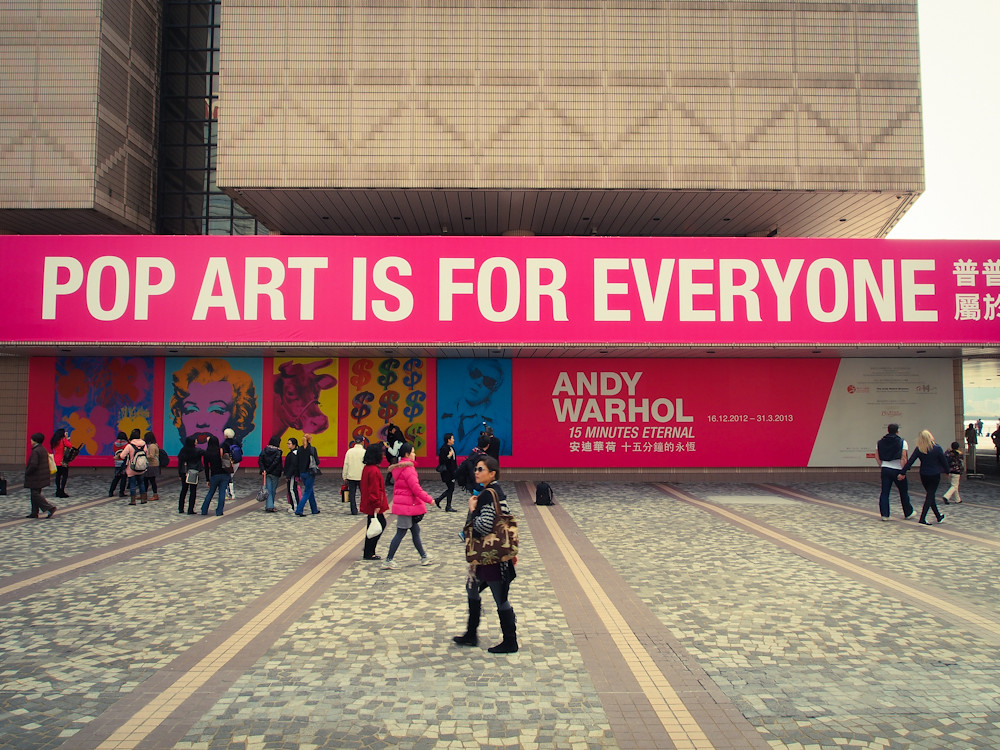
"Pop art is for everyone" by sobermusings is licensed under CC BY 2.0
Are you fascinated by culture and pop art? Do you want to know its origins? You can't miss this post!
Bright and youthful colors, comics, advertising and everyday objects ... are still present today in the art world. The one known as Pop-Art was an artistic movement born in the mid-50s in the United Kingdom, which soon moved to the United States (where it reached its peak) in the early 60s.
The Origin of Pop - Art: Abstract Expressionism and Jackson Pollock
In its early days, a group of young British artists started a plastic renovation process in response to earlier Abstract Expressionism. This movement, which originated in the United States in the 40s, was characterized by violent strokes made with few colors and without figuration that showed the emotional drama of the time. In addition, they used to be large-format paintings, waiting to be exhibited in galleries, to be sold for very large sums of money. And, the art collecting was synonymous with a high social status.
Among the expressionists highlights the painter Jackson Pollock (1912 - 1956) and his technique of dripping, in which the paint is allowed to drip onto the canvas or splatter with it.

«MOMA Pollock» by CKH is licensed under CC BY-ND 2.0
They lived in a greedy world obsessed with fame, where the vision of art from an intellectual point of view, of the meaning of the work, acquired special importance.
The rise of Pop - Art: rebellion against the prevailing Abstract Expressionism
Among artists tired of the excessive intellectualization of art and its consequent estrangement from the public, the Pop - Art movement was born. It is characterized by the use of simple and simple figures, full of color, fun and youthful. It is a popular art, accessible to the people.
The representation of simple, everyday objects stands out, displayed as consumer products, as if they were advertisements. They are mass-produced products, devoid of subjectivity, in an ironic response to the elitist and consumer society of the time. This apparent coldness and simplicity occurs in contrast to the deep meaning that was given to the works of the Abstract Expressionists.
If there is a key figure in this movement and whose works are still in fashion today, it is undoubtedly Andy Warhol's. (1928-1987). Bold and cheeky, Warhol used symbols of American culture in his paintings, images that generated attraction in themselves: the Coca - Cola bottle, Campbell's soup cans and even Marilyn Monroe herself.

“Museum of Modern Art (MoMA)” by wyliepoon is licensed under CC BY-NC-ND 2.0
On one occasion he commented:
What's great about this country is that the United States has started a tradition in which the richest consumers buy essentially the same things as the poorest. You can be watching TV, you see an advertisement for Coca-Cola and you know that the President drinks Coca-Cola, Liz Taylor drinks Coca-Cola and you think that you can drink Coca-Cola too. A queue is a queue, and no money in the world can make you find a better queue than the one the beggar on the corner is drinking. All the queues are the same and all the queues are good. Liz Taylor knows it, the President knows it, the beggar knows it, and you know it.
Other artists of the Pop - Art movement: Lichtenstein and Wesselmann
Other artists of the time who also used cold and rational figurations in opposition to the prevailing expressionism, were Lichtenstein and Wesselmann.
Roy Lichtenstein (1923-1967) is known for his large-scale comic vignettes generally using figures from advertisements. Their use of onomatopoeia in them is also very characteristic. Everyone who sees his works today will surely recognize them!

Image by shogunangel is licensed under CC BY-NC-ND 2.0
Tom Wesselmann (1931 - 2004), is very popular for his female nudes, cheeky and funny. In very defined forms but with limited elements, the female body is represented without prejudice, in a very simple and cold way, as if it were an advertising poster of the time.
Surely you know some of these works, as they are still in fashion today!